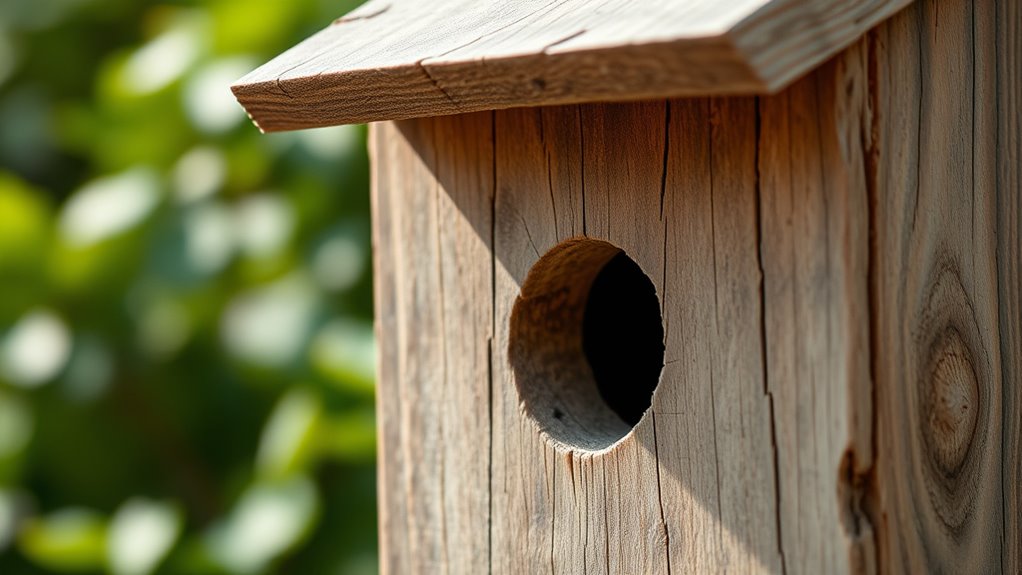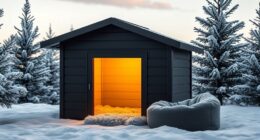To build a simple birdhouse from scrap wood, start by selecting untreated, leftover pieces that are safe for birds. Cut the wood to create a box with an appropriate entrance hole for your local species, adding ventilation holes for airflow. Assemble the pieces securely, then mount the birdhouse at a safe height in a sheltered spot. Regularly check and clean it to keep pests away. If you want to know more, you’ll find tips on customizing and maintaining your birdhouse below.
Key Takeaways
- Select untreated scrap wood and cut pieces to appropriate dimensions for the birdhouse design.
- Assemble the sides, floor, and roof securely, ensuring the entrance hole is properly sized for target bird species.
- Add ventilation holes and a perch if desired, then seal the exterior with non-toxic, weatherproof paint or sealant.
- Mount the birdhouse at an appropriate height in a sheltered, predator-safe location.
- Regularly inspect, clean out old nesting materials, and maintain the structure for ongoing use.

Building a birdhouse from scrap wood is a rewarding and eco-friendly project that anyone can tackle. Not only does it give you a chance to recycle leftover materials, but it also provides a safe space for local birds to nest and raise their young. When designing your birdhouse, think about the size and entrance hole, making sure they’re appropriate for the species you want to attract. Using scrap wood means you can customize your birdhouse easily, adjusting dimensions or adding features like perches or ventilation holes. Keep in mind that the wood should be untreated to avoid exposing birds to harmful chemicals.
Create a custom, eco-friendly birdhouse from scrap wood for safe nesting.
Once you’ve assembled your birdhouse, consider the importance of providing suitable nesting materials nearby. Birds often gather moss, grass, feathers, and twigs to line their nests, so placing natural materials around the birdhouse can encourage occupancy. Avoid synthetic or processed items that might harm the birds. Position your birdhouse at a height that offers safety from predators, and ensure it’s mounted securely to withstand weather conditions. Remember, the location should also be sheltered from strong winds and direct sunlight, helping to create a comfortable environment for nesting.
Birdhouse maintenance is key to keeping it a safe, inviting space year after year. Regularly inspect your birdhouse for damage or wear, especially after storms or harsh weather. Clean out old nesting materials at the end of each breeding season to prevent the spread of parasites or diseases. Use gloves and a brush to remove debris, and avoid using chemical cleaners—warm water and a mild soap are enough. Repainting or sealing the exterior with non-toxic, weatherproof paint can extend the lifespan of your birdhouse, but avoid sealing the entrance hole, which should remain unobstructed.
You should also monitor the birdhouse for signs of pests or predators. If you notice wasps, ants, or other unwanted visitors, take steps to remove or deter them without harming the birds. During birdhouse maintenance, check that the entrance hole remains accessible and unobstructed, allowing easy access for the birds and ensuring proper ventilation. Keeping the birdhouse clean and secure not only encourages birds to return but also helps protect their nests from predators and environmental elements. Additionally, selecting self-watering or waterless planters nearby can support a healthy environment for the nesting birds by providing consistent moisture without frequent intervention.
Frequently Asked Questions
What Tools Are Necessary for Building the Birdhouse?
You’ll need a tools checklist that includes a saw, drill, screwdriver, measuring tape, and a pencil. Safety gear is essential, so wear gloves and safety glasses to protect yourself. Use the saw to cut the scrap wood to size, and the drill to make entrance and ventilation holes. The screwdriver helps assemble the pieces securely. Always prioritize safety when working with these tools to build your birdhouse efficiently and safely.
How Do I Ensure the Birdhouse Is Weatherproof?
Think of your birdhouse as a fortress against the elements. To keep it weatherproof, apply a rainproof coating to the wood, sealing out moisture. Incorporate good ventilation design to prevent humidity buildup, which could lead to rot. Elevate the house slightly off the ground, and make certain the roof overhangs to shed rain. These steps help your feathered friends stay dry and safe through all seasons.
Which Types of Scrap Wood Are Safest for Birds?
You should use types of safe wood like cedar, pine, or plywood labeled non-toxic, avoiding any treated or painted wood with toxic chemicals. These woods are durable and safe for birds. Always check for preventing toxic materials, so your feathered friends stay healthy. Steer clear of pressure-treated or stained wood, and ensure your scrap wood is clean and free of pesticides. This way, you provide a safe, cozy shelter for birds.
How Do I Clean and Maintain the Birdhouse?
Think of your birdhouse as a cozy nest—keeping it clean keeps your feathered friends happy. To clean and maintain it, follow a regular maintenance schedule, ideally once after each breeding season. Use gentle cleaning tips, like removing old nesting material and scrubbing with a mild solution, then let it dry thoroughly. This way, you guarantee a safe, inviting space for birds to thrive season after season.
What Is the Ideal Size for Different Bird Species?
You should tailor the size of your birdhouse to match different bird species preferences and nesting space requirements. For small birds like chickadees, keep the entrance around 1 1/8 inches and the interior about 4×4 inches. Larger species like bluebirds need a 1 1/2-inch entrance and a 5×5-inch interior. Adjust dimensions accordingly to provide comfy, safe nesting spaces that attract your desired bird species.
Conclusion
Now that you’ve built your birdhouse from scrap wood, you’ve created a cozy haven that welcomes feathered friends like a warm hug. With just a few simple steps, you’ve turned discarded pieces into a charming home in the trees. Think of it as planting a tiny seed of nature’s magic, where birds can sing their melodies and brighten your day. Your efforts transform scraps into a sanctuary, making your yard feel alive and full of life.








